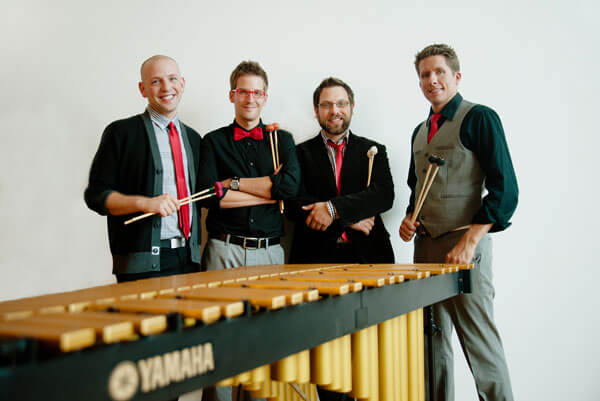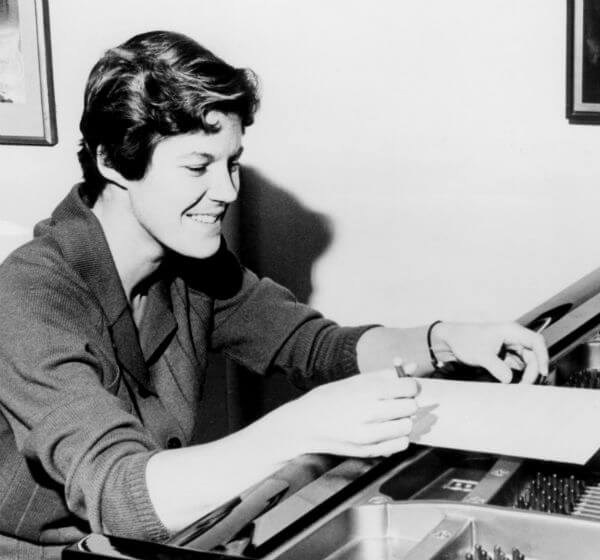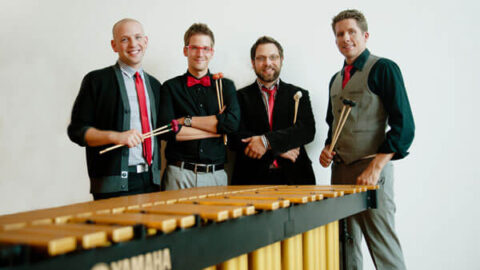 Musicworks’ Drum Up! was a surprisingly raucous affair for a contemporary classical music event, but how can the night be hush with a spirited ensemble like TorQ Percussion Quartet performing throughout? The Musicworks organization’s annual fundraiser, held at The Gladstone Hotel in Toronto on Wednesday, July 3, 2013, marked the launch of Musicworks Editions – a series of limited edition artworks created by Canadian artists and composers – as well as the magazine’s impressive new website. From TorQ’s point of view, Drum Up! was a celebration of the featured ensemble’s first full concert season this year. In between their performances, TorQ keeps busy with their educational programs such as their upcoming percussion seminar at Acadia University in Nova Scotia and concerts held for aspiring musicians in schools across Canada. Musicworks, which spurs the development of new and passionate audiences for experimental music, shares in this commitment to music education and outreach with their own Musicworks in the Classroom program, bringing the publication to Canadian post-secondary institutions at no cost to the participating schools or the students who are enrolled.
Musicworks’ Drum Up! was a surprisingly raucous affair for a contemporary classical music event, but how can the night be hush with a spirited ensemble like TorQ Percussion Quartet performing throughout? The Musicworks organization’s annual fundraiser, held at The Gladstone Hotel in Toronto on Wednesday, July 3, 2013, marked the launch of Musicworks Editions – a series of limited edition artworks created by Canadian artists and composers – as well as the magazine’s impressive new website. From TorQ’s point of view, Drum Up! was a celebration of the featured ensemble’s first full concert season this year. In between their performances, TorQ keeps busy with their educational programs such as their upcoming percussion seminar at Acadia University in Nova Scotia and concerts held for aspiring musicians in schools across Canada. Musicworks, which spurs the development of new and passionate audiences for experimental music, shares in this commitment to music education and outreach with their own Musicworks in the Classroom program, bringing the publication to Canadian post-secondary institutions at no cost to the participating schools or the students who are enrolled.

It comes as no surprise then that Musicworks partnered up with TorQ (Richard Burrows, Adam Campbell, Jamie Drake and Daniel Morphy) for this intimate evening of experimental music and sonic experimentation. For both parties involved, musical appreciation is as much a form of enjoyment as it is an opportunity to engage, encourage and enlighten audiences whether they are young or old, new to the scene, or already in the know about contemporary classical music. Education is, after all, a process dedicated to the arousing of curiosity.
TorQ’s performances throughout the night were perfectly tailored to this spirit of inquisitiveness. Their first piece was Steve Reich’s Drumming (1971), featuring four sets of small tuned bongo drums arranged in a line with the four members of TorQ divided equally across the row of instruments. Drumming employs one of Reich’s trademark techniques known as ‘phasing’, where a repeated pattern played in unison begins to diverge as one or more players start to change their tempo or rhythm slightly. The result is an incongruous pattern that still overlaps at certain beats, but creates new patterns whenever the unison is displaced. Listening to Drumming reminded me of moments when, sitting in your car, you notice that the turn signal is ticking at exactly the same pace as the light signal of the car in front of you; after a few seconds, however, the synchronization peters out and becomes syncopation instead. TorQ’s playful delivery of Drumming made the performance seem full and complete, despite the fact that the original composition was written for nine or more percussionists. The playfulness was also evident in the body language of the members of TorQ themselves, as they seemed to thoroughly enjoy performing together as an ensemble.
Next was John Cage’s Third Construction, a comparatively dated composition from 1941. Nevertheless, it featured a deluge of fascinating instruments: maracas, claves, gongs, quijadas, graduated cans, tom toms, a lion’s roar, and a couple of Heineken kegs, among other things. The items were spread out — as if simulating a neighbourhood yard sale — across three different tables on stage, and were all called into action at various intervals throughout the undeniably groovy piece of noise-music.

The exploration of noise versus music was also a prevalent theme in the third and last piece of the night, Ann Southam’s Natural Resources – or, what to do ‘til the power comes on (1981). This sound game, originally commissioned by the Canadian Electronic Ensemble, featured a singular table taped on both sides which created four spaces (beats) for two players to hit at a regular interval. Two volunteers were then asked to place items of all sorts into these spaces (which one might call ‘found sound’), move them around, and take them away at their discretion while the two players continued to regularly strike at each space or whatever happened to occupy it at the time. The display of collaborative improvisation was intriguing and endlessly entertaining, and the audience certainly learned a thing or two about taking things in stride when faced with a power outage.
Drum Up! was without a doubt one of the more casual and lighthearted contemporary music events that I’ve attended in recent memory. And for that I am thankful, because it proves that the seriousness of the music does not necessarily mandate a serious atmosphere — an issue that tends to alienate potential listeners from attending new music performances. Both Musicworks and TorQ Percussion Quartet have done a fine job of reaching out to people beyond their own musical and geographical communities, and those commendable efforts alone are a worthy cause for celebration.
























